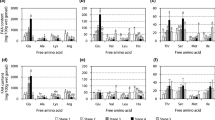The overall chemical composition and contents of free (FAA) and bound amino acids and related compounds from various parts of the ascidian Halocynthia aurantium from the Sea of Japan were studied. The amounts of FAA and related nitrogenous compounds were rather high in all parts. The 42 total compounds were dominated by taurine, the absolute content of which was especially high in tunic, exceeding those in mantle and total organs by 1.6 and 2.17 times, respectively. A total of 18 amino acids were identified, eight of which were essential and 10 of which, non-essential. Total internal organs had the highest content of essential amino acids (50.61%); tunic, the lowest (35.01%). Aspartic acid was the dominant non-essential amino acid in all parts (5.84–10.16%), especially in tunic.
Similar content being viewed by others
References
G. B. Elyakov and V. A. Stonik, Izv. Akad. Nauk, Ser. Khim., No. 1, 1 (2003).
T. N. Pivnenko, Rybovod. Rybn. Khoz., 12, 5 (2006).
V. A. Stonik and G. A. Tolstikov, Vestn. Ross. Akad. Nauk, 78 (8), 675 (2008).
W. S. Jang, K. N. Kim, Y. Sh. Lee, M. H. Nam, and I. H. Lee, FEBS Lett., 521, 81 (2002).
E. S. Motorya, T. N. Pivnenko, and A. S. Gazha, Tikhookean. Med. Zh., 3, 28 (2009).
B.-D. Choi and S.-J. Kang, J. Korean Fish. Soc., 27 (4), 344 (1994).
M. Ookubo and T. Matsuno, Comp. Biochem. Physiol., Part B: Biochem. Mol. Biol., 81 (1), 137 (1985).
K. Anno, K. Otsuka, and N. Seno, Biochim. Biophys. Acta, 362, 215 (1974).
B.-D. Choi, S.-J. Kang, and K.-H. Lee, J. Korean Fish. Soc., 29 (3), 345 (1996).
T. N. Pivnenko, P. A. Zadorozhnyi, V. A. Zarubkina, and L. A. Ivanushko, Vestn. Biotekhnol. Fiz.-Khim. Biol., 10 (1), 29 (2014).
O. V. Tabakaeva and A. V. Tabakaev, Chem. Nat. Compd., 52, 468 (2016).
O. V. Tabakaeva and A. V. Tabakaev, Chem. Nat. Compd., 52, 966 (2016).
N. B. Ayushin, I. P. Petrova, and L. M. Epshtein, Vopr. Pitan., 6, 6 (1997).
N. B. Ayushin, I. P. Petrova, and L. M. Epshtein, Izv. TINRO (Tikhookean. Nauchno-Issled. Rybokhoz. Tsentr), 125, 52 (1999).
Acknowledgment
The work was sponsored by the Russian Science Foundation (Project No. 14-50-00034).
Author information
Authors and Affiliations
Corresponding author
Additional information
Translated from Khimiya Prirodnykh Soedinenii, No. 4, July–August, 2017, pp. 615–618.
Rights and permissions
About this article
Cite this article
Tabakaeva, O.V., Tabakaev, A.V. Amino Acids and Related Compounds of the Ascidian Halocynthia aurantium from the Sea of Japan. Chem Nat Compd 53, 722–725 (2017). https://doi.org/10.1007/s10600-017-2099-8
Received:
Published:
Issue Date:
DOI: https://doi.org/10.1007/s10600-017-2099-8



